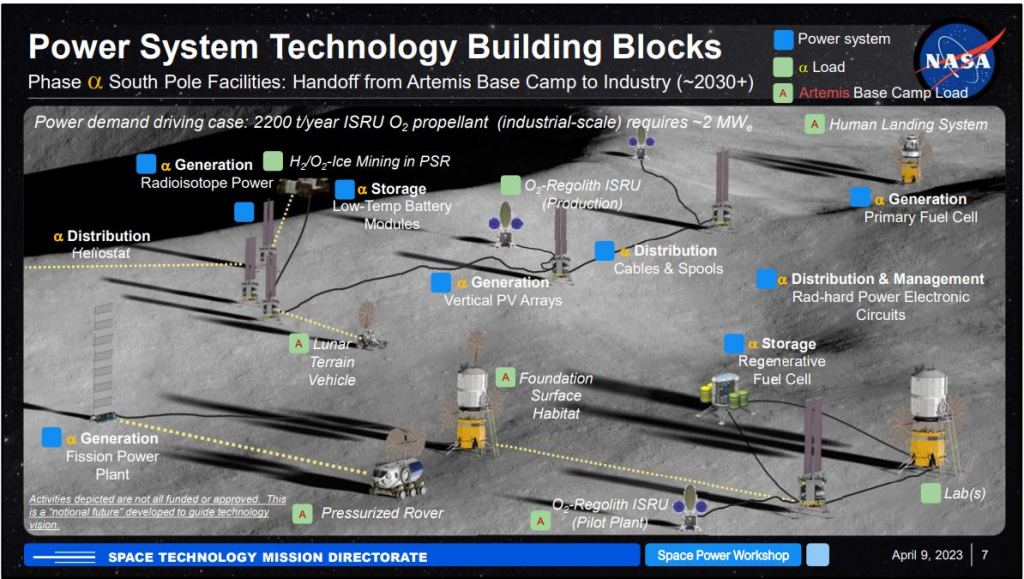Despite all the hype surrounding the coming of the commercial space age, NASA and other governmental agencies will still play a vital role in the early stages of getting much of the infrastructure up and running before commercial actors can come in. That role will primarily be filled by being the first (and sometimes only) customer for a wide variety of companies that hope to profit from exploiting space resources.
Governments around the world are beginning to realize the critical role they will play in the potential new industrial age, and America's House of Representatives took a step towards accepting that responsibility when it gave NASA 6 months to come up with a plan for developing a plan for electrical power infrastructure on the Moon. In response, NASA's Principal Technologist for Power and Energy Storage, Dr. John H Scott, presented a preliminary plan for developing that infrastructure at the Space Power Workshop, held in Torrance, California, at the end of April.
The challenges of getting power on the Moon have been well documented. Sunlight isn't consistent enough, and batteries that operate at freezing temperatures aren't large enough for typical renewable energy plans to be viable at the Lunar South Pole, which will likely serve as the first landing site for NASA's Artemis program. However, large amounts of power are needed for in-situ resource utilization, such as making rocket fuel to get landers back to Earth and effectively operate a base camp.
Dr. Scott breaks down his role at NASA in this interview.Credit - Zpryme YouTube ChannelBut the vision that the House of Representatives asked for looked past the preliminary Artemis missions to where there could potentially be a significant private industrial presence on the Moon. Dr. Scott breaks that vision down into three phases - the Artemie Base Camp phase, the ? phase where NASA is a primary customer of commercially available power services and an ? phase where NASA is one of many other (presumably commercial) customers that utilize existing power services.
In some surprisingly good graphics for a government presentation, Dr. Scott also lays out essential technology requirements for each phase and identifies what loads the technologies might be used to power. In the ? phase, the technologies range from fuel cells to heliostats, and they can be used to power anything from rovers to full-blown laboratories.
These technologies grow in complexity as the industrial base on the Moon expands into the ? phase, where power system components include ISRU silicon photovoltaics, and some power loads would include long-term surface habitats. Dr. Scott also showcases gaps in those technologies by describing "envisioned future priorities" for technology development.
UT video on using nuclear power in space.In Kim Stanley Robinson's Mars Trilogy, one of the first astronauts on Mars is understandably happy when they find the base's nuclear reactor. Dr. Scott thinks a similar technology might also be helpful on the Moon, as his Gap A technology is a mobile fission surface power source. However, the technology he points out as the most important might come as a surprise to non-engineers.
Radiation-hardened power electronics circuits are highest on his development priority list. This is because, in his words, "None of these building blocks or growth ambitions will do any good if the whole grid goes dark on the first Solar Storm. This is where we're going to get bit."
He's right - the Moon lacks Earth's magnetic field that (mostly) protects electronics down on the planet from the solar particles that could wreak havoc on the power infrastructure if they were to hit the surface. At the voltages needed to provide power to an entire lunar colony, there has been little to no development for the power electronic circuits, such as converters and inverters. Therefore, the radiation hardening of these components is paramount, as the entire system would go down without them.
There are some options that NASA is already supporting, including working on semiconductors made from exotic materials such as diamonds. But further support is needed to prove technologies that can be relied upon to support the entire Lunar infrastructure.
Luckily, the House of Representatives also recognized that and offered $40M in funding in 2023 to support the development of these technologies, with the intention that they will be demonstrated by 2026. That should be in time for any significant permanent presence on the Moon, but, as Dr. Scott said in his presentation, "Much more study to be done." He's also right to point out that, if these efforts are successful, 200 years after Jules Verne wrote *From the Earth to the Moon*, there might be permanent life on our nearest neighbor, and it might be making the barren surface into another home.
Learn More:
John H Scott / NASA - Lunar Surface Power Systems
UT - Power on the Moon. What Will it Take to Survive the Lunar Night?
UT - NASA is Upping the Power on its Lunar Wattage Challenge!
UT - How do you get Power into Your Lunar Base? With a Tower of Concrete Several Kilometers High
Lead Image:
Artist Depiction of Artemis Astronauts on the Moon.
Credit - NASA
 Universe Today
Universe Today

